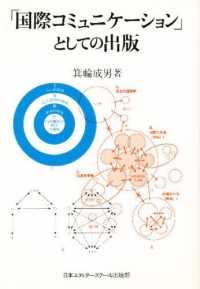- ホーム
- > 洋書
- > ドイツ書
- > Humanities, Arts & Music
- > Arts
- > history of arts
Full Description
"Liveliness" is the dominant topos in the art and discourse on art of the early modern era. It is characterized by a paradox, since the works only seem to live. But what is also reflected in the fascination with almost living works at the same time is the impossibility of drawing rigid lines of demarcation between the living and the dead. Here, art explores what also occupied natural philosophy at the time in an experimental way.
The book examines the transitions between living and dead in case studies, for instance, based on early tombs, anatomical renderings, and sculptural monochromy as well as on the history of coloring, Vasari's teleology, Michelangelo's non-finito, and Titian's portraits. What come into play are eroticism, monetary theory, the luster of eyes, and still-lifes, and also visual poetry, princely triumphal processions, and light and sculpture in the Baroque.








